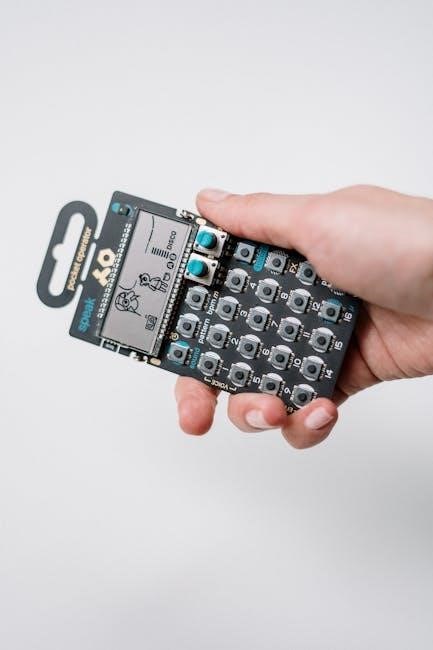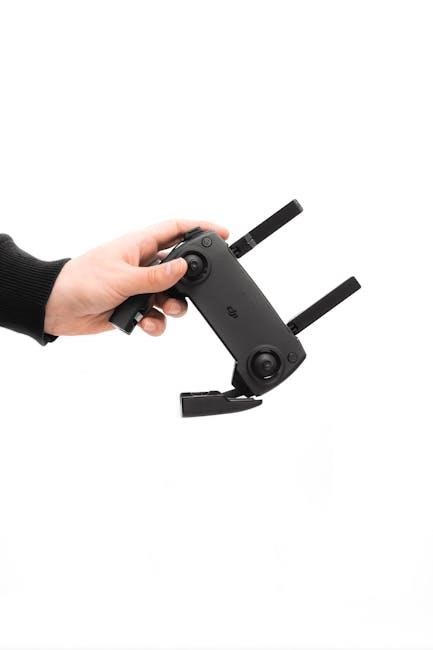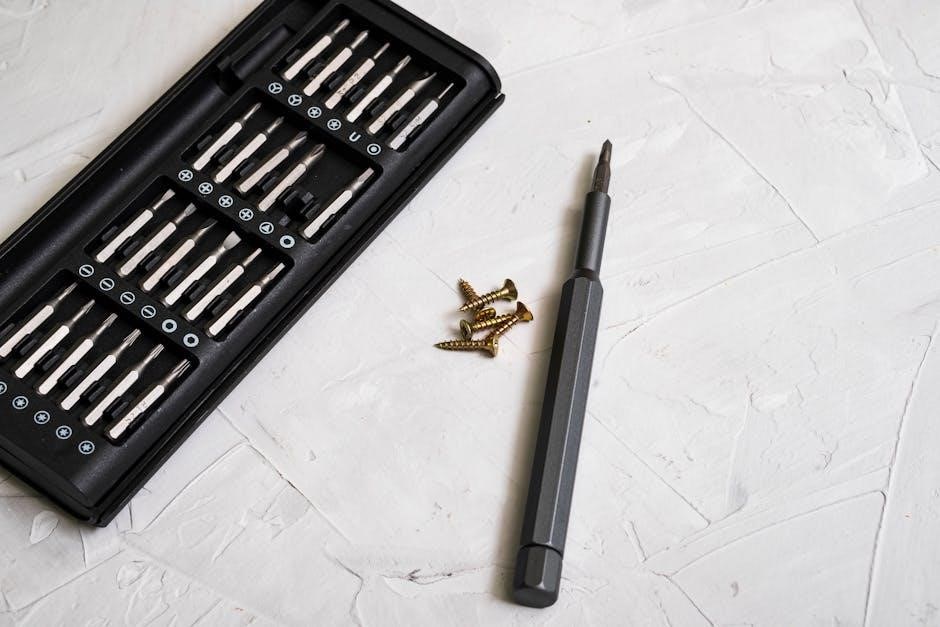
Product Overview
The Boss VE-20 is a vocal effects processor designed to enhance live performances with real-time pitch correction and harmony capabilities, offering a compact, user-friendly solution for singers and performers to achieve professional-grade vocal enhancements with advanced customization options.
The Boss VE-20 Vocal Performer is a cutting-edge vocal effects processor designed for singers, beatboxers, and vocalists seeking to enhance their live and studio performances. This compact, user-friendly device offers real-time vocal processing, enabling artists to create dynamic, layered, and polished sounds effortlessly. With its intuitive interface and robust feature set, the VE-20 is ideal for both beginners and professionals. It provides a wide range of effects, including harmonies, pitch correction, vocoding, and looping, making it a versatile tool for crafting unique vocal performances. Its portability and real-time processing capabilities make it a must-have for modern vocal artists.
1.2. Key Features of the Boss VE-20
The Boss VE-20 Vocal Performer boasts an array of innovative features designed to elevate vocal performances. It includes real-time vocal processing, harmony generation, pitch correction, and vocoding. The device also features a built-in looper for creating layered vocal soundscapes and an LCD display for easy navigation. With 30 preset memory locations and real-time controls, users can customize effects to suit their style. The VE-20 supports both XLR and 1/4-inch inputs and outputs, ensuring versatility in various setups. Its compact design, battery or DC power options, and intuitive interface make it a powerful tool for vocalists seeking to enhance their creativity and performance quality.
1.3. Target Audience for the Boss VE-20

The Boss VE-20 is designed for vocalists seeking to enhance their performances with high-quality effects and real-time processing. It appeals to professional singers, studio vocalists, and live performers who need versatility and creativity. Hobbyists and beginners also benefit from its intuitive interface and ease of use. The device is ideal for musicians who want to add depth to their vocals with harmonies, looping, and pitch correction. Its portability and robust features make it suitable for both stage and studio environments, catering to a wide range of vocalists aiming to elevate their sound and artistic expression.

Installation and Setup
This section guides users through the process of setting up the Boss VE-20, including hardware installation, connectivity options, power management, and software registration for optimal functionality.
2.1. Unboxing and Hardware Setup
Carefully unbox the Boss VE-20 and verify all components are included, such as the device, power supply, USB cable, and owner’s manual. Place the VE-20 on a flat surface, ensuring proper ventilation for cooling. Connect your microphone to the XLR input and other equipment to the appropriate ports. Secure all cables firmly to prevent accidental disconnection. Handle the device gently to avoid damage. Once unboxed, position the VE-20 in your setup, ensuring easy access to controls and inputs. Refer to the manual for diagrams and detailed connectivity options.
2.2. Connecting the Boss VE-20 to Your System
Connect your microphone to the XLR input on the Boss VE-20. Use the 1/4-inch input for guitar or line-level sources. To integrate with your setup, connect the XLR or 1/4-inch outputs to a mixer, amplifier, or recording interface. For MIDI control, link the VE-20 to your MIDI-compatible devices using the MIDI IN and OUT ports. Ensure all cables are securely connected to avoid signal loss. Adjust the input level knob to optimize the signal strength. Power on the device and test the connections to confirm proper functionality. Refer to the manual for specific diagrams and configuration examples.
2.3. Powering the Device (Battery and DC Options)
The Boss VE-20 offers flexible power options to suit your needs. For portability, use six AA alkaline batteries, providing up to 6 hours of operation. To install, remove the battery compartment cover and insert the batteries correctly. For extended use, connect the included DC adapter (PSA-120S) to a power source. Ensure the adapter is securely plugged into both the device and the outlet. Avoid using low-quality adapters to prevent damage. Always turn off the device when not in use to conserve battery life. Store batteries properly when not in use to maintain performance and longevity.
2.4. Registering the Product and Software
Registering your Boss VE-20 ensures access to updates, support, and exclusive content. Visit the official Boss website and navigate to the product registration page. Create or log in to your Roland/Boss account, then enter your VE-20’s serial number, found on the underside of the unit or packaging. Follow the on-screen instructions to complete the process. Additionally, register any included software to unlock full functionality. Registration is crucial for warranty validation, software updates, and troubleshooting assistance. Ensure all details are accurate to avoid issues with future support or updates. This step is essential for maximizing your device’s potential.

Operational Guide
This section provides a comprehensive guide to operating the Boss VE-20, covering essential functions like voice processing, harmony creation, and looping.
3.1. Navigating the Boss VE-20 Interface
The Boss VE-20 features an intuitive interface designed for easy navigation. The central LCD display shows current settings and preset information. Below the screen, buttons allow selection of voice characters and effects. Knobs on the left adjust levels and parameters, while buttons on the right activate Harmony and Looper functions. The footswitch enables hands-free control during performance. Input/output jacks are located at the top for connecting microphones and external devices. To navigate, use the cursor buttons to scroll through menus and adjust settings. The “Write” button saves presets for quick recall. Refer to the manual for detailed instructions on maximizing the VE-20’s capabilities.
3.2. Adjusting Input Levels for Optimal Sound
To achieve optimal sound with the Boss VE-20, proper input level adjustment is crucial. Start by connecting your microphone and powering on the device. Locate the input level knob on the top panel. Turn the knob while monitoring the LCD display, which shows real-time level meters. Aim for peak levels to reach just below the maximum indicator to avoid distortion. Adjust based on your microphone’s sensitivity and performance style—higher levels for soft vocals and lower for loud performances. Ensure the signal is clear and strong, and refer to the manual for specific guidelines and additional tips.
3.3. Selecting and Customizing Voice Characters
The Boss VE-20 offers a variety of voice characters to enhance your vocal sound. To select a character, navigate to the “Voice” menu using the cursor buttons and choose from the preset options. Each character provides a unique tonal quality, from smooth to bright. Customize the sound by adjusting parameters like pitch, tone, and level using the dedicated knobs. Experiment with the settings to find the perfect balance for your voice. Save your customized settings as user presets for quick access during performances. This feature allows you to tailor the voice character to match your musical style and preferences.
3.4. Using the Harmony Function
The Boss VE-20’s Harmony Function allows you to create lush vocal textures by adding one or two backup voices to your main vocal. To activate the harmony, press the HARMONY button and select the desired harmony type using the cursor buttons. Choose from multiple harmony options, including higher, lower, or double-track sounds. The VE-20 analyzes your input and generates harmonies in real time. Adjust the harmony level with the HARMONY knob to blend it seamlessly with your voice. You can also customize the harmony pitch and tone to suit your performance. This feature enhances your vocal sound without requiring additional singers.
3.5. Looping Vocals for Layered Soundscapes
The Boss VE-20’s looper function allows you to create intricate vocal layers by recording and overdubbing your voice. Press the LOOP button to engage the looper. Use the REC, PLAY, and STOP buttons to control the recording process. You can overdub additional layers by pressing REC again while the loop plays. Adjust the loop level with the LOOP knob to blend it with your live vocals. The VE-20 supports up to 50 seconds of mono recording, enabling you to craft rich, layered soundscapes. This feature is ideal for live performances, adding depth and texture to your vocal arrangements.
3.6. Connecting External Pedals for Enhanced Control
The Boss VE-20 allows for external pedal connectivity to enhance control during performances. Use a footswitch, such as the FS-5L or FS-6, to activate features like looping or harmony without manual adjustment. Connect the pedal to the PEDAL jack on the rear panel. This setup enables hands-free operation, allowing you to focus on your vocals. The external pedal can also be used to toggle between effects or switch presets seamlessly. This feature is particularly useful for live performances, offering greater flexibility and improving your overall workflow with the VE-20. Ensure the pedal is compatible with the VE-20 for optimal functionality.

Advanced Features
The Boss VE-20 offers advanced features including a built-in looper, customizable effects, and a high-resolution LCD display for enhanced vocal processing and performance control.
4.1. Exploring the Looper Function
The Boss VE-20’s Looper function allows vocalists to create layered soundscapes by recording and overdubbing vocals in real time. With up to 30 seconds of recording time, users can craft intricate vocal textures, perfect for live performances or practice sessions; The looper supports unlimited overdubs, enabling the creation of rich, multi-layered harmonies. It also features undo and redo options, making it easy to refine loops without starting over. This feature is ideal for solo artists or groups looking to expand their vocal capabilities and add depth to their music.
4.2. Customizing Effects and Presets
The Boss VE-20 offers extensive customization options for effects and presets, allowing users to tailor their sound to suit any performance. With a variety of built-in effects such as reverb, delay, and harmony, vocalists can create unique tones by adjusting parameters in real time. Presets can be customized and saved for quick access, ensuring seamless transitions during live shows. The intuitive interface enables easy navigation through effects, while the ability to store up to 50 user presets provides ample flexibility for diverse musical styles. This feature-rich system empowers artists to craft distinctive vocal sounds that match their creative vision.
4.3. Utilizing the Built-In LCD Display
The Boss VE-20 features a built-in LCD display that provides clear visual feedback for navigating effects, presets, and settings. This high-contrast screen ensures excellent visibility, even in low-light environments. With the LCD, users can easily scroll through the 50 user presets and 50 factory presets, making it simple to select the perfect sound for any performance. The display also shows real-time parameter adjustments, allowing for precise control over effects like reverb, delay, and harmony. Additionally, the LCD screen guides users through the process of saving custom presets, ensuring a seamless and intuitive experience. This feature enhances overall usability and creativity.
4.4. Managing and Editing Presets
The Boss VE-20 allows users to manage and edit presets with ease, enabling customization to suit individual preferences. With 50 user presets and 50 factory presets, vocalists can organize their sounds efficiently. Users can select a preset, adjust parameters, and save changes to create unique voices. The LCD display simplifies navigation, while buttons provide quick access to editing functions; Presets can be renamed for clarity and organized into categories for quick recall. This feature ensures that performers can tailor their sound without losing their custom settings, maintaining a smooth and efficient workflow during live performances or studio recordings.

Connectivity and Compatibility
The Boss VE-20 offers versatile connectivity with XLR inputs/outputs, USB for computer integration, and MIDI compatibility. It supports phantom power for condenser mics and seamless integration with other audio gear.

5.1. Input/Output Configuration
The Boss VE-20 features a straightforward input/output configuration, designed for seamless integration into vocal setups. It includes a combo XLR/TRS input for microphones or instruments and a dedicated XLR input for an additional microphone. The unit provides both XLR and 1/4-inch TRS outputs for connecting to mixers, audio interfaces, or PA systems. Additionally, a MIDI input/output allows for external control and synchronization with MIDI-compatible devices. A headphones jack is included for private monitoring, making it ideal for live performances and studio recordings. The balanced outputs ensure high-quality audio transmission, reducing noise and interference.
5.2. Wired Connectivity Options
The Boss VE-20 offers versatile wired connectivity to integrate seamlessly with your musical setup. It features a combination XLR/TRS input for connecting microphones or instruments, ensuring high-quality audio capture. Dual XLR outputs provide a direct link to mixers, audio interfaces, or PA systems. Additionally, a dedicated 1/4-inch input allows for auxiliary devices, while a MIDI input/output enables synchronization with other MIDI-compatible gear. The unit also includes a USB port for firmware updates and data transfers, ensuring compatibility with modern recording environments. These wired options ensure reliable and flexible connectivity for both live performances and studio applications.
5.3. Compatibility with Other Boss Devices
The Boss VE-20 is designed to integrate seamlessly with other Boss devices, ensuring a cohesive workflow for musicians. It works well with Boss multi-effects pedals like the GT-1000 and loop stations such as the RC-500 and RC-300. By connecting these devices using TRS cables, users can create a powerful system for vocal and instrumental processing. The VE-20 also supports Boss’s dedicated DC power adapters, allowing multiple devices to operate simultaneously without power conflicts. This compatibility enhances flexibility, enabling musicians to craft rich, layered soundscapes and expand their creative possibilities during live performances or studio sessions.

Troubleshooting Common Issues
Troubleshooting the Boss VE-20 involves checking power sources, ensuring proper connectivity, and adjusting audio settings. Resetting to factory settings can resolve persistent issues effectively.
- Check battery levels or DC power connectivity for sudden shutdowns.
- Verify cable connections to prevent audio dropouts or distortions.
- Adjust input levels to optimize sound quality and avoid clipping.
- Perform a factory reset if custom settings cause unexpected behavior.
6.1. Resolving Power-Related Problems
If the Boss VE-20 fails to power on, check the power button functionality and ensure batteries are correctly installed. Verify DC power sources, such as adapters, are functioning and properly connected. If using batteries, ensure they are fresh or fully charged. A faulty power adapter or incorrect voltage can cause issues; always use the recommended BOSS DC adapter. Intermittent power may indicate weak battery connections or loose DC jack contacts. Clean contacts gently with a soft cloth. Resetting the device to factory settings can resolve persistent issues, but ensure all custom presets are backed up beforehand. Always refer to the manual for detailed troubleshooting steps.
6.2. Fixing Connectivity Issues
Connectivity problems with the Boss VE-20 can often be resolved by checking the physical connections. Ensure all cables are securely plugged into the correct ports. Verify that the device is properly powered on and that the power source is stable. If using a USB connection, try a different USB port or cable to rule out issues. For MIDI connectivity, ensure MIDI settings are correctly configured in your system. If the device is not being recognized, restart both the Boss VE-20 and your connected system. If problems persist, consult the manual or contact Boss support for assistance.
6.3. Addressing Audio Quality Concerns
If you experience distortion, low volume, or unwanted noise, check the input levels first. Ensure the Input Level knob is set appropriately for your microphone. If the signal is too hot, it may cause distortion. For low volume, increase the gain or check if the output volume is set correctly. Noise issues can often be resolved by using a noise gate pedal or ensuring proper shielding of cables. Additionally, verify that the device is updated with the latest firmware. If hum or buzz persists, try using a high-quality DC adapter or isolating the power supply. These steps should help restore optimal audio quality.
6.4. Resetting the Boss VE-20 to Factory Settings
Resetting the Boss VE-20 to factory settings can resolve persistent issues or restore default functionality. To perform a factory reset, press and hold the power button while turning on the device. Use a screwdriver to press the small reset button located on the rear panel. Hold for 5 seconds until the LED flashes twice. Release the button and wait for the device to reboot. Note that this process erases all user presets and customizations, returning the VE-20 to its original settings. Ensure backups are made before proceeding. The device will now function as if freshly unboxed.

FAQs and User Queries
This section addresses common questions and concerns about the Boss VE-20, providing troubleshooting tips and guidance for optimal use. Find quick solutions here.
7.1. Can the Boss VE-20 be Used with Multiple Microphones?
The Boss VE-20 is designed to process a single vocal microphone input. While it cannot directly connect multiple microphones simultaneously, you can use an external mixer or audio interface to combine signals before sending them to the VE-20. This setup allows you to blend multiple vocal or instrumental sources for a layered sound. Ensure proper input level balancing to maintain optimal audio quality. For advanced multi-mic setups, consider routing through additional hardware to achieve the desired configuration.
7.2. Does the Boss VE-20 Support Lead Mute Function?
The Boss VE-20 does not feature a Lead Mute function. This device focuses on vocal processing, harmonies, and looping, offering tools to enhance live vocal performances. While it provides extensive control over effects and sound shaping, muting the lead vocal track is not among its capabilities. For such functionality, users may need to integrate additional equipment or software designed for vocal mixing and editing. The VE-20 excels in real-time vocal enhancements but does not support lead muting during playback or recording.
7.3. Can the Boss VE-20 be Paired with Other Pedals?
The Boss VE-20 can seamlessly integrate with other pedals, enhancing your vocal processing capabilities. It features both XLR and 1/4″ inputs and outputs, allowing easy connection to external devices. For example, you can place the VE-20 in a signal chain with reverb, delay, or distortion pedals. Additionally, the VE-20 supports external control via MIDI or expression pedals, enabling real-time adjustments during performances. Experimenting with different pedal combinations can unlock unique vocal textures and effects. Always ensure proper setup and testing to maintain compatibility and optimal performance.
7;4. How to Resolve Vocal Duplication Issues
If you encounter vocal duplication issues with the Boss VE-20, start by checking the harmony settings. Ensure that the harmony function is not inadvertently layered or duplicated. Adjust the Harmony Level knob to lower the effect intensity. Next, verify that the Loop function is not active, as it may cause unintended layering of vocals. Also, check the input levels to ensure they are optimized, as excessive gain can cause phasing or duplication effects. If the issue persists, reset the VE-20 to factory settings or update the firmware to the latest version. This should resolve most duplication problems effectively.

Support and Resources
The Boss VE-20 user manual is available on the official Boss website or via authorized retailers. It provides detailed instructions for operation, troubleshooting, and maintenance. For additional assistance, users can contact Boss customer support directly through email, phone, or the support portal. Furthermore, online forums, tutorials, and YouTube channels offer valuable tips and guides to help users maximize the VE-20’s potential.
8.1. Accessing the Official Boss VE-20 Manual
To access the official Boss VE-20 manual, visit the Boss official website and navigate to the support section. Enter “VE-20” in the search bar to locate the specific manual. Download the PDF version for detailed instructions on operation, features, and troubleshooting. If you cannot find it online, contact Boss customer support or check with authorized retailers, as they may provide a physical copy. Ensure to register your product for access to exclusive resources and updates. The manual is essential for understanding all functions and optimizing your use of the Boss VE-20.
8.2. Reaching Boss Customer Support
For assistance with the Boss VE-20, contact Boss customer support through their official website. Visit the Boss support page and navigate to the “Contact Us” section. You can submit a support ticket, call their hotline, or use live chat if available. Ensure you have your product details and a clear description of your issue ready. Support is available in multiple languages, and regional offices can provide localized assistance. Check your region’s website for specific contact options. Boss support is committed to resolving your queries efficiently.
8.3. Finding Additional Tutorials and Guides
For users seeking additional tutorials and guides beyond the official manual, numerous online resources are available. The Boss VE-20 community is active, with many musicians sharing their tips and tricks on forums and social media groups. YouTube hosts a wealth of video tutorials, covering everything from basic setup to advanced effects customization. Additionally, music gear websites often feature in-depth reviews and walkthroughs. To find these resources, search for keywords like “Boss VE-20 tutorials” or “VE-20 vocal effects guides” on search engines or video platforms. This ensures access to a broad range of learning materials.

